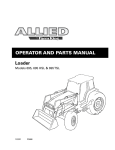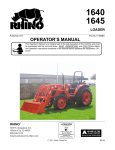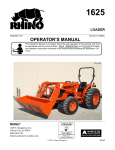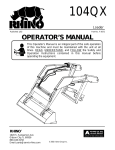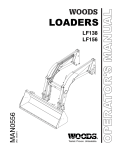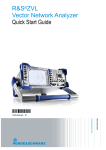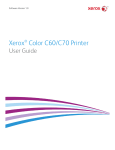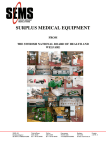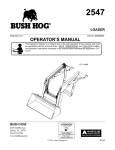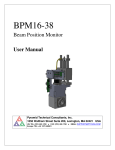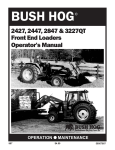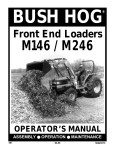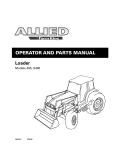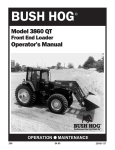Download Alamo RHINO 7214 MSL User's Manual
Transcript
7214 MSL ® Loader Published 12/04 Part No. F-3778 OPERATOR’S MANUAL This Operator’s Manual is an integral part of the safe operation of this machine and must be maintained with the unit at all times. READ, UNDERSTAND, and FOLLOW the safety and Operation Instructions contained in this manual before operating the equipment. RHINO® 1020 S. Sangamon Ave. Gibson City, IL, 60936 800-446-5158 Email: [email protected] © 2004 Alamo Group, Inc. TO THE OWNER/OPERATOR/DEALER All implements with moving parts are potentially hazardous. There is no substitute for a cautious, safe-minded operator who recognizes the potential hazards and follows reasonable safety practices. The manufacturer has designed this implement to be used with all its safety equipment properly attached to minimize the chance of accidents. BEFORE YOU START!! Read the safety messages on the implement and shown in your manual. Observe the rules of safety and common sense! SAFETY HAZARD SIGNAL WORDS There are three levels of hazard intensity identified by signal words DANGER, WARNING and CAUTION. The level of hazard intensity is identified by the following definitions. DANGER - DANGER Immediate hazards which will result in severe injury or death. WARNING WARNING - Hazards or unsafe practices which could result in minor personal injury or death. CAUTION - CAUTION THIS SAFETY SYMBOL MEANS ATTENTION! BECOME ALERT! YOUR SAFETY IS INVOLVED! Hazards or unsafe practices which could result in minor personal injury or property damage. PELIGRO LEA EL INSTRUCTIVO Si No Lee Ingles, Pida Ayuda a Alguien Que Si Lo Lea Que le Traduzca las Medidas de Seguridad. Read and understand the complete Warranty Statement found in this Manual. Fill out the Warranty Registration Form in full and return it within 30 Days. Make certain the Serial Number of the Machine is recorded on the Warranty Card and on the Warranty Form that you retain. The use of will-fit parts will void your warranty and can cause catastrophic failure with possible injury or death. TABLE OF CONTENTS SAFETY SECTION . . . . . . . . . . . . . . . . . . . . . . . . . . . . . . . . . . . . . . . . . 1-1 Safety Precautions . . . . . Safety Hazard Signal Words Decal Locations . . . . . . Safety Decals. . . . . . . . . . . . . . . . . . . . . . . . . . . . . . . . . . . . . . . . . . . . . . . . . . . . . . . . . . . . . . . . . . . . . . . . . . . . . . . . . . . . . . . . . . . . . . . . . . . . . . . . . . . . . . . . . . . . . . . . . . . . . . . . . . . . . . . . 1-2 1-7 1-8 1-10 INTRODUCTION SECTION . . . . . . . . . . . . . . . . . . . . . . . . . . . . . . . . . . . . 2-1 Introduction . . . . . . . . . . . . . . . . . . . . . . . . . . . . . . . . . . . . . . . . . 2-2 Specifications. . . . . . . . . . . . . . . . . . . . . . . . . . . . . . . . . . . . . . . . 2-3 ASSEMBLY SECTION . . . . . . . . . . . . . . . . . . . . . . . . . . . . . . . . . . . . . . . 3-1 Dismounting and Mounting Loader to Tractor . . . . . . . . . . . . . . . . . . . . . . . 3-2 Mounting Attachment To Loader, Dismounting Attachment From Loader . . . . . . . . . 3-3 OPERATION SECTION. . . . . . . . . . . . . . . . . . . . . . . . . . . . . . . . . . . . . . . 4-1 Preparing Tractor, Operating Loader, Filling Bucket . . . . . . . . . . Lifting Load, Carrying Load, Dumping Bucket, Lowering Bucket. . . . Operating Float Control, Loading From Bank . . . . . . . . . . . . . Peeling & Scraping, Loading Truck & Spreaders From Pile, Backfilling Handling Large Heavy Objects . . . . . . . . . . . . . . . . . . . . . Operating Grapple Fork . . . . . . . . . . . . . . . . . . . . . . . . Operating Bale Spear . . . . . . . . . . . . . . . . . . . . . . . . . Operation of MSL. . . . . . . . . . . . . . . . . . . . . . . . . . . . . . . . . . . . . . . . . . . . . . . . . . . . . . . . . . . . . . . . . . . . . . . . . . . . . . . . . . . . . . . . . . . . . . . . . . . . . . . . . . . . 4-2 4-3 4-4 4-5 4-6 4-7 4-10 4-11 MAINTENANCE SECTION . . . . . . . . . . . . . . . . . . . . . . . . . . . . . . . . . . . . . 5-1 Daily Maintenance . . . . . . . Lift Cylinder Service . . . . . . Tilt Cylinder Service . . . . . . Replacing Wear Bushings . . . Adjusting Bucket Level Indicator Hydraulic Trouble Shooting. . . Torque Chart . . . . . . . . . . F-3778-12-04 © 2004 Alamo Group Inc. . . . . . . . . . . . . . . . . . . . . . . . . . . . . . . . . . . . . . . . . . . . . . . . . . . . . . . . . . . . . . . . . . . . . . . . . . . . . . . . . . . . . . . . . . . . . . . . . . . . . . . . . . . . . . . . . . . . . . . . . . . . . . . . . . . . . . . . . . . . . Rhino is a registered trademark of Alamo Group Inc. . . . . . . . . . . . . . . . . . . . . . . . . . . . . . . . . . . . . . . . . . . . . . . . . . . . . . . . . . . . . . . . . . . . . . . 5-2 5-3 5-4 5-5 5-5 5-6 5-7 SAFETY SECTION Safety Section 1-1 © 2004 Alamo Group Inc. SAFETY SAFETY PRECAUTIONS A careful operator operates best. Most accidents can be SAFETY avoided by observing certain precautions. Read all precautions that follow before operating your tractor and loader to help prevent accidents. Equipment should be operated only by those who are responsible and instructed to do so. GENERAL 1. Read your Operator's Manuals carefully before using tractor or loader. Lack of operating knowledge can lead to accidents. 2. Replace damaged or illegible safety decals. See pages 1-10 & 1-11 for required decals. 3. Operate tractor and loader only from operator's seat. TRACTOR 1. Use an approved roll bar and seat belt for safe operation. Overturning a tractor without a rollbar can result in death or injury. If your tractor is not equipped with a rollbar and seat belt, see your Tractor Dealer. 2. Equip your tractor with FOPS (Falling Object Protective Structure) before installing or operating loader. 3. Always use seat belt when rollbar is installed. Do not use seat belt if rollbar is removed from tractor. 4. Add recommended wheel ballast and/or rear weight as recommended in owner's manual to provide good stability. 5. Move rear wheels to widest settings recommended to increase stability. 6. Move and turn tractor at low speeds. LOADER 1. Improper use of a loader can cause serious injury or death. 2. Do not lift or carry anybody on loader, in bucket or on attachment. 3. Never allow anyone to get under loader bucket or reach through lift arms when bucket is raised. 4. Do not walk or work under a raised loader or bucket or attachment unless it is securely blocked or held in position. 5. Avoid overhead wires and obstacles when loader is raised. Contacting electric lines can cause electrocution. 6. Make sure all parked loaders are on a hard, level surface. Engage all safety devices. OPERATING LOADER 1. As owner of this loader, it is your responsibility to be certain anyone operating this loader has read this manual first to be aware of safe operation of your tractor and loader. 2. Exercise caution when operating any loader with a raised loaded bucket or fork. 3. Avoid loose fill, rocks and holes. They can be dangerous for loader operation or movement. 4. Use care when operating on steep grades to maintain proper stability. Always carry bucket or attachment as low as possible. 5. Allow for loader length when making turns. Whenever you see this symbol F-3778-12-04 © 2004 Alamo Group Inc. 6. Stop loader arms gradually when lowering or lifting. 7. Use caution when handling loose or shiftable loads. 8. Carry bucket or attachment at a low position during transport for better visibility. 9. When parking or servicing, lower bucket to ground, stop engine and set park brakes before leaving tractor seat. 10. Operate loader controls only when properly seated at controls. 11. Using front end loaders without special attachments for handling large heavy objects such as large round or rectangular bales, logs and oil drums is NOT RECOMMENDED. 12. Handling large heavy objects can be extremely dangerous due to: Danger of rolling tractor over. Danger of upending tractor. Danger of objects rolling or sliding down loader arms onto operator. 13. If you must perform this sort of work (see 12 above), protect yourself by: Use proper attachments only. Never lift load higher than necessary to clear ground when moving. Ballast tractor rear to compensate for load. Never lift large objects with equipment that does not have an anti-rollback device. Move slowly and carefully, avoiding rough terrain. MAINTENANCE 1. When servicing or replacing pins in cylinder ends, buckets, etc., always use a drift and hammer of non-sparking material. Failure to do so could result in injury from flying metal fragments. 2. Do not modify or alter or permit anyone else to modify or alter loader or any of its components or any loader function without first consulting your Dealer. If you have any questions regarding loader modifications contact your Rhino Dealer. 3. Always wear safety goggles when servicing or repairing tractor or loader. 4. Escaping hydraulic/diesel fluid under pressure can penetrate skin causing serious personal injury. DO NOT use your hand to check for leaks. Use a piece of cardboard or paper to search for leaks. Stop engine and relieve pressure before connecting or disconnecting hydraulic or diesel lines. Tighten all connections before starting engine or pressurizing lines. If any fluid is injected into skin, obtain medical attention immediately or gangrene may result. 5. Do not tamper with relief valve setting. Valve relief is factoryset. Changing relief setting can cause overloading of your tractor or loader and serious operator injury may result. It means: ATTENTION! BECOME ALERT! YOUR SAFETY IS INVOLVED! Safety Section 1-2 SAFETY PELIGRO! Si no lee Ingles, pida ayuda a alguien que si Io lea para que Ie traduzca las medidas de seguridad. SAFETY DANGER! Never operate the Power Unit or Implement until you have read and completely understand this Manual, the Power Unit Operators Manual, and each of the Safety Messages found in the Manual or on the Power Unit and Implement. Learn how to stop the Power Unit engine suddenly in an emergency. Never allow inexperienced or untrained personnel too operate the Power Unit and Implement without supervision. Make sure the operator has fully read and understood the manuals prior to operation. WARNING! Always maintain the safety decals in good readable condition. If the decals are missing, damaged, or unreadable, obtain and install replacement decals immediately. WARNING! Make certain that the Slow Moving Vehicle (SMV) sign is installed in such a way as to be clearly visible and legible. When transporting the Equipment use the Power Unit flashing warning lights and follow all local traffic regulations. WARNING! Operate this Equipment only with a Tractor equipped with an approved roll-over-protective system (ROPS). Always wear seat belts. Serious injury or even death could result from falling off the tractorparticularly during a turnover when the operator could be pinned under the Operator Protective Structure. WARNING! Do not modify or alter this Implement. Do not permit anyone to modify or alter this Implement, any of its components or any Implement function. DANGER! BEFORE leaving the Power Unit seat, always engage the brake and/or set the Power Unit transmission in parking gear, disengage the auxiliary hydraulics, stop the engine, remove the key, and wait for all moving parts to stop. Place the Power Unit shift lever into a low range or parking gear to prevent the tractor from rolling. Never dismount a Power Unit that is moving or while the engine is running. Operate the Power Unit controls from the operator seat only. F-3778-12-04 © 2004 Alamo Group Inc. Safety Section 1-3 SAFETY SAFETY DANGER! Never allow children to operate or ride on the Power Unit or Implement. DANGER! Do not mount the Power Unit while the Power Unit is moving. Mount the Power Unit only when the Power Unit and all moving parts are completely stopped. DANGER! Start the Power Unit only when properly seated in the Power Unit seat. Starting a Power Unit in gear can result in injury or death. Read the Power Unit operator's manual for proper starting instructions. DANGER! Never work under the Implement, the framework, or any lifted component unless the Implement is securely supported or blocked up to prevent sudden or inadvertent falling which could cause serious injury or even death. WARNING! The operator and all support personnel should wear hard hats, safety shoes, safety glasses, and proper hearing protection at all times for protection from injury including injury from items thrown by the equipment. WARNING! PROLONGED EXPOSURE TO LOUD NOISE MAY CAUSE PERMANENT HEARING LOSS! Tractors with or without an Implement attached can often be noisy enough to cause permanent hearing loss. We recommend that you always wear hearing protection if the noise in the Operators position exceeds 80db. Noise over 85db over an extended period of time will cause severe hearing loss. Noise over 90db adjacent to the Operator over an extended period of time will cause permanent or total hearing loss. Note: Hearing loss from loud noise [from tractors, chain saws, radios, and other such sources close to the ear] is cumulative over a lifetime without hope of natural recovery F-3778-12-04 © 2004 Alamo Group Inc. Safety Section 1-4 SAFETY DANGER! Do not operate this Equipment with hydraulic oil leaking. Oil is expensive and its presence could present a hazard. Do not check for leaks with your hand! Use a piece of heavy paper or cardboard. High- pressure oil streams from breaks in the line could penetrate the skin and cause tissue damage immediately by a physician knowledgeable and skilled in this procedure. DANGER! Transport only at safe speeds. Serious accidents and injuries can result from operating this equipment at unsafe speeds. Understand the Power Unit and Implement and how it handles before transporting on streets and highways. Make sure the Power Unit steering and brakes are in good condition and operate properly. Before transporting the Power Unit and Implement, determine the safe transport speeds for you and the equipment. Make sure you abide by the following rules: 1. Test the Power Unit at a slow speed and increase the speed slowly. Apply the Brakes smoothly to determine the stopping characteristics of the Power Unit and Implement. As you increase the speed of the Power Unit the stopping distance increases. Determine the maximum safe transport speed for you and this Equipment. 2. Test the equipment at a slow speed in turns. Increase the speed through the turn only after you determine that it is safe to operate at a higher speed. Use extreme care and reduce your speed when turning sharply to prevent the Power Unit and Implement from turning over. Determine the maximum safe turning speed for you and this equipment before operating on roads or uneven ground. 3. Only transport the Power Unit and Implement at the speeds that you have determined are safe and which allow you to properly control the equipment. Be aware of the operating conditions. Do not operate the Power Unit with weak or faulty brakes. When operating down a hill or on wet or rain slick roads, the braking distance increases: Use extreme care and reduce your speed. When operating in traffic always use the Power Unit's flashing warning lights and reduce your speed. Be aware of the traffic around you and watch out for the other guy. WARNING! Never attempt to lubricate, adjust, or remove material from the Implement while it is in motion or while Power Unit engine is running. Make sure the Power Unit engine is off before working on the Implement! WARNING! Periodically inspect all moving parts for wear and replace when necessary with authorized service parts. Look for loose fasteners, worn or broken parts, and leaky or loose fittings. Make sure all pins have cotter pins and washers. Serious injury may occur from not maintaining this machine in good working order. F-3778-12-04 © 2004 Alamo Group Inc. Safety Section 1-5 SAFETY including gangrene. If oil does penetrate the skin, have the injury treated SAFETY SAFETY WARNING! Always read instructions carefully when and handling comply oil, fully solvents, with the cleansers, manufacturers and any other chemical agent. DANGER! Never run the Power Unit engine in a closed building or without adequate ventilation. The exhaust fumes can be hazardous to your health. DANGER! KEEP AWAY FROM ROTATING ELEMENTS to prevent entanglement and possible serious injury or death. DANGER! Never allow children to play on or around Power Unit or Implement. Children can slip or fall off the Equipment and be injured or killed. Children can cause the Implement to shift or fall crushing themselves or others. WARNING! Do not exceed the rated PTO speed for the Implement. Excessive PTO speeds can cause Implement driveline failures resulting in serious injury. NEVER use drugs or alcohol immediately before or while operating the DANGER! Power Unit and Implement. Drugs and alcohol will affect an operators alertness and coordination and therefore affect the operators ability to operate the equipment safely. Before operating the Power Unit or Implement, an operator on prescription or over-the-counter medication must consult a medical professional regarding any side effects of the medication that would hinder their ability to operate the Equipment safely. NEVER knowingly allow anyone to operate this equipment when their alertness or coordination is impaired. Serious injury or death to the operator or others could result if the operator is under the influence of drugs or alcohol. DANGER! Operate the Power Unit and/or Implement controls only while properly seated in the operator's seat with the seat belt securely fastened around you. Inadvertent movement of the Power Unit or Implement may cause serious injury or death. F-3778-12-04 © 2004 Alamo Group Inc. Safety Section 1-6 SAFETY WARNING! Never interfere with factory-set hydraulic calibrations. Any change in calibration could cause a failure of the equipment and result in injury. Always shut the Power Unit completely down, place the transmission in park, and set the parking brake before you or anyone else attempts to connect or disconnect the Loader. DANGER! Never crawl under a raised implement supported solely by the Power Unit boom. Release of the control lever or mechanical failure will result in the Implement falling and possible injury or death. Always securely block up the Implement before crawling underneath to perform repairs and service. WARNING! Relieve hydraulic pressure prior to doing any maintenance or repair work on the implement. Place the Loader on the ground or securely supported on blocks or stands, disengage the auxiliary hydraulics and turn off engine. Push and pull the control levers several times to relieve pressure prior to starting any maintenance or repair work. SAFETY HAZARD SIGNAL WORDS There are three levels of hazard intensity identified by signal words DANGER, WARNING and CAUTION. The level of hazard intensity is identified by the following definitions. ! DANGER - Immediate hazards which will result in severe injury or death. WARNING WARNING - Hazards or unsafe practices which could result in minor personal injury or death. CAUTION CAUTION - Hazards or unsafe practices which could result in minor personal injury or property damage. F-3778-12-04 © 2004 Alamo Group Inc. THIS SAFETY SYMBOL MEANS ATTENTION! BECOME ALERT! YOUR SAFETY IS INVOLVED! Safety Section 1-7 SAFETY DANGER! SAFETY SAFETY 8 1 5 CL 3 9 4 7 6 LEFT SIDE OF LOADER 8 2 5 6 3 9 RIGHT SIDE OF LOADER 11 10 12 S MAN UAL R’ 13 LEFT SIDE LEFT MID MOUNTING BRACKET F-3778-12-04 © 2004 Alamo Group Inc. OPE R A O T IN SID E 13 MANUAL CANISTER Safety Section 1-8 SAFETY SAFETY ITEM PART NO. QTY. TYPE DESCRIPTION 1 2 3 4 5 6 7 8 9 10 11 12 13 49695 51447 48434 46776 51902 49703 48858 35674-5 48322 47730 48921 46779 00776031 LOGO LOGO DANGER WARNING WARNING MODEL DANGER STRIPE DANGER WARNING DANGER WARNING MANUAL CANISTER Rhino, Left Rhino, Right Loader Safety Loader Safety Loader Removal/Reinstallation Safety 7214 Electric Shock White, 54" Support Loader Handling Bales/Do Not Carry People Use ROPS, Seatbelt, Rear Ballast Bucket Shift (Suspended Front Axle Only) Read Operator’s Manual F-3778-12-04 © 2004 Alamo Group Inc. 1 1 2 1 2 2 1 2 2 1 1 1 1 Safety Section 1-9 SAFETY NOTE: Safety decal locations are shown on DANGER page 1-8. Replace decal if damaged or illegible. Replacement decals are available from your SAFETY dealer. DANGER DANGER Use ROPS and seatbelt at all times. Add recommended rear ballast. Operate tractor at low speeds. Do not walk or work under a raised loader. Lower loader to ground when parked. Failure to comply may result in serious injury and/or death. Failure to comply may result in serious injury or death. 48921 Keep bucket and boom away from overhead electric lines. Failure to comply will result in serious injury or death. 48858 48434 11 - - 48921 7 - - 48858 WARNING 3 - - 48434 DANGER TO SUPPORT LOADER ARMS Raise loader, place loader support onto left cylinder rod and pin. Slowly lower loader until support takes the load. Loader support must be installed prior to working under raised loader. Failure to comply may result in serious injury or death. TO REMOVE SUPPORT Raise loader, remove pin, and support, then store. 48322 9 - - 48322 WARNING LOADER SAFETY Know all operation, warning and safety instructions in the operator’s manual before operating the loader. Operate loader only from operator’s seat. Carry bucket low during transport for better visibility and to avoid overturns. Use wheel ballast and / or rear weight for stability as recommended in the operator’s manual. When parking or servicing unit, lower the bucket to the ground, stop engine, and set the parking brake to avoid tractor movement. Failure to follow any of the instructions above can cause serious injury to the operator or other persons in are. (Replacement manuals are available from your dealer.) Do not handle round bales or large objects unless loader is equipped with proper attachments. Operate loader only with approved hydraulic valves. Handle raised loads with caution. Carry loads low. Failure to comply may result in serious injury and/or death. WARNING WARNING TO AVOID INJURY DURING REMOVAL OR REINSTALLATION OF LOADER Read and understand instructions in operator’s manual Make sure detached loader is parked on hard, level ground. Always have a bucket mounted to loader when it is removed from tractor. Do not permit bystanders within 10 feet of loader. Do not remove bucket or repair loader if it is not mounted on tractor. Failure to comply could cause loader to collapse. Failure to follow above instructions can cause serious injury. 51902 5 - - 51902 46776 Do not lift or carry anybody in loader or work from bucker or any other attachment. Failure to comply may result in serious injury or death. 47730 10 - - 47730 WARNING When the loader is mounted to a tractor with SuperSteer™, the bucket will shift in the opposite direction from which the front wheels are turned. Maximum shift will be approximately 8 inches and most noticeable when the tractor is stationary. Failure to heed this warning can result in serious injury to the operator or other persons. 46779 4 - - 46776 F-3778-12-04 © 2004 Alamo Group Inc. 12 - - 46779 Safety Section 1-10 SAFETY SAFETY ® ® 1 - - 49695 2 - - 51447 6 - - 49703 8 - - 35674-5 S MAN UAL R’ OPE R A O T IN 13 - - 00776031 F-3778-12-04 © 2004 Alamo Group Inc. Safety Section 1-11 SID E SAFETY SAFETY FEDERAL LAWS AND REGULATIONS This section is intended to explain in broad terms the concept and effect of federal laws and regulations concerning employer and employee equipment operators. This section is not intended as a legal interpretation of the law and should not be considered as such. Employer-Employee Operator Regulations U.S. Public Law 91-596 (The Williams-Steiger Occupational and Health Act of 1970) OSHA This Act Seeks: “...to assure so far as possible every working man and woman in the nation safe and healthful working conditions and to preserve our human resources...” DUTIES Sec. 5 (a) Each employer(1) shall furnish to each of his employees employment and a place of employment which are free from recognized hazards that are causing or are likely to cause death or serious physical harm to his employees; (2) shall comply with occupational safety and health standards promulgated under this Act. (b) Each employee shall comply with occupational safety and health standards and all rules, regulations and orders issued pursuant to this Act which are applicable to his own actions and conduct. OSHA Regulations OSHA regulations state in part: “At the time of initial assignment and at least annually thereafter, the employer shall instruct every employee in the safe operation and servicing of all equipment with which the employee is, or will be involved.” Employer Responsibilities: To ensure employee safety during Tractor and Implement operation, it is the employer’s responsibility to: 1. Train the employee in the proper and safe operation of the Tractor and Implement. 2. Require that the employee read and fully understand the Tractor and Implement Operator’s manual. 3. Permit only qualified and properly trained employees to operate the Tractor and Implement. 4. Maintain the Tractor and Implement in a safe operational condition and maintain all shields and guards on the equipment. 5. Ensure the Tractor is equipped with a functional ROPS and seat belt and require that the employee operator securely fasten the safety belt and operate with the ROPS in the raised position at all times. 6. Forbid the employee operator to carry additional riders on the Tractor or Implement. 7. Provide the required tools to maintain the Tractor and Implement in a good safe working condition and provide the necessary support devices to secure the equipment safely while performing repairs and service. 8. Require that the employee operator stop digging if bystanders or passersby come within 10 yards. Child Labor Under 16 Years of Age Some regulations specify that no one under the age of 16 may operate power machinery. It is your responsibility to know what these regulations are in your own area or situation. (Refer to U.S. Dept. of Labor, Employment Standard Administration, Wage & Home Division, Child Labor Bulletin #102.) F-3778-12-04 © 2004 Alamo Group Inc. Safety Section 1-12 INTRODUCTION SECTION Introduction Section 2-1 © 2004 Alamo Group Inc. INTRODUCTION INTRODUCTION INTRODUCTION This manual provides operation, maintenance, assembly and parts identification for your new loader. Your loader has been designed to give many years of satisfactory service. Successful operation and long life of the loader depends on proper maintenance and operation. Please read this manual carefully and follow all instructions. Correct assembly, operation and maintenance will save you much time and expense. Also follow instructions included with loader mounting and hydraulic kits to insure that loader is installed correctly to tractor. NOTE: This safety alert symbol identifies important safety messages in this manual. Observe and follow all safety messages to prevent personal injury. Reference to left-hand and right-hand used in this manual refers to position of operator when seated in the operating position of loader. If at any time you have a service problem with your loader or need new parts, contact your local dealer. Your dealer will need your loader model number and serial number to give you prompt efficient service. Parts orders must give complete description, correct part number, total amount required, model number, all necessary serial numbers, method of shipment and shipping address. F-3778-12-04 © 2004 Alamo Group Inc. Introduction Section 2-2 INTRODUCTION 7214 SPECIFICATIONS Specifications will vary with tractor, tire size, hydraulic system and bucket used. The specifications are given for a loader equipped with 96" H.D. material bucket, quick attach device and 4-bar linkage, operated with an average tractor hydraulic system of 25 GPM with engine operating at 2300 RPM, and control valve relief setting of 2750 PSI. Break-away Capacity At Pivot Point . . . . . . . . . . . . . . . . . . . . . . . . . . . . . 9260 # 800mm Forward of Pivot Point . . . . . . . . . . . . . . . . . . . . . 8540 # Lift capacity at Full Height At Pivot Point . . . . . . . . . . . . . . . . . . . . . . . . . . . . . 5840 # 800mm Forward of Pivot Point . . . . . . . . . . . . . . . . . . . . . 5140 # Lowering Time . . . . . . . . . . . . . . . . . . . . . . . . . . . . . . . . 4.6 sec. Attachment Dumping Time. . . . . . . . . . . . . . . . . . . . . . . . . . . 3.0 sec. Attachment Rollback Time . . . . . . . . . . . . . . . . . . . . . . . . . . . 2.9 sec. Weight w/ Average Mounting Kit, Hose Kit, and 96" HD Material Bucket . . . . . 3603 # Lift Cylinder: Stroke . . . . . . . . . . . . . . . . . . . . . . . . . . . . . . . . 28.88 in. Piston Diameter . . . . . . . . . . . . . . . . . . . . . . . . . . . . 3.50 in. Rod Diameter . . . . . . . . . . . . . . . . . . . . . . . . . . . . . 1.75 in. Bucket Cylinder: Stroke . . . . . . . . . . . . . . . . . . . . . . . . . . . . . . . . 16.00 in. Piston Diameter . . . . . . . . . . . . . . . . . . . . . . . . . . . . 3.50 in. Rod Diameter . . . . . . . . . . . . . . . . . . . . . . . . . . . . . 1.75 in. (A) Maximum Lift Height at Pivot Pin . . . . . . . . . . . . . . . . . . . . . . 169 in. (B) Maximum Height Under Bucket. . . . . . . . . . . . . . . . . . . . . . . 159 in. (C) Clearance with Bucket Dumped . . . . . . . . . . . . . . . . . . . . . . 133 in. (D) Reach at Maximum Height . . . . . . . . . . . . . . . . . . . . . . . . . 44 in. (E) Maximum Dump Angle . . . . . . . . . . . . . . . . . . . . . . . . . . . 71° (F) Reach with Attachment on ground . . . . . . . . . . . . . . . . . . . . . 103 in. (G) Attachment Rollback Angle . . . . . . . . . . . . . . . . . . . . . . . . 39° (H) Digging Depth . . . . . . . . . . . . . . . . . . . . . . . . . . . . 4 in. (J) Overall Height in Carry Position . . . . . . . . . . . . . . . . . . . . . . 89 in. E D B A C J G F H (Manufacturers estimated specifications and design subject to change without notice.) F-3778-12-04 © 2004 Alamo Group Inc. Introduction Section 2-3 INTRODUCTION Raising Time . . . . . . . . . . . . . . . . . . . . . . . . . . . . . . . . . 6.6 sec. ASSEMBLY SECTION Assembly Section 3-1 © 2004 Alamo Group Inc. ASSEMBLY DISMOUNTING LOADER AND MOUNTING LOADER TO TRACTOR Figure B Figure A STORAGE POSITION OPERATION POSITION Remove linch pin and hitch pin to fold down parking stand Secure parking stand down with hitch pin and linch pin loader upright pin Figure C Right Side View mount vertical stop surface Linch Pin mount pin saddle ASSEMBLY 1" Figure D Hitch Pin DISMOUNTING LOADER CAUTION: Keep clear of dropping parking stands. Dropping parking stands could cause WARNING: To avoid injury injury. during installation or removal of loader, do not allow bystanders within 10 feet of loader and 6. Remove linch pins and 1-1/2" hitch pins from loader upright. Remove tarp strap securing loader hoses bucket or optional attachment. from tractor handrail. WARNING: Always have a heavy attachment, such as a bucket, mounted to 7. Start tractor engine and release brakes. Retract loader when it is removed from tractor. Pallet bucket cylinders to allow parking stands to contact fork, bale spear, or similar attachments are ground. too light to safely counterbalance loader boom arms when loader is dismounted from WARNING: It is important not to put excessive tractor. weight on parking stands by retracting lift cylinders. Damage may result. 1. Locate tractor and loader on firm level ground. 2. With 8. bucket raised above ground, tilt down approximately 30 degrees from level. Extend lift cylinders 10" to 12" to rotate top of loader uprights forward, allowing tractor out to be of mid mounting pushed brackets, rearward. Retract bucket cylinders until lower loader upright pins clear 3. mount pin saddles and front tires and/or fenders (see Lower boom by retracting lift cylinders to lift tractor Figure D). front end (tires can be off ground). 4. Stop engine. Allow tractor front end to lower by relaxing ONLY lift cylinders with control lever. This will 9. Move tractor rearward approximately 6", taking care not to stretch hydraulic hoses. remove pressure on hitch pins (see Figure C). 10.Stop tractor engine and set parking brake. Relax lift cylinders and bucket cylinders by moving each control NOTE: Do not relax bucket cylinders. lever in both directions. Disconnect hydraulic hoses at 5. Set parking brake. Rotate parking stands from storage position to operation position by removing mid mounting couplers on right side of loader. Install plastic dust plugs and caps on couplers. linch pins and hitch pins. Reinstall hitch pin and linch pin when parking stands are in operation position (see Figure B). F-3778-12-04 © 2004 Alamo Group Inc. 11.Start tractor engine and release brakes. Slowly back tractor out of and away from loader. Assembly Section 3-2 ASSEMBLY MOUNTING LOADER 5. Stop engine. Allow tractor front end to lower by relaxing ONLY lift cylinders with control lever. WARNING: To installation or avoid removal injury of during loader NOTE: Do not relax tilt cylinders. or attachment, do not allow bystanders within 10 feet of loader and bucket or optional 6. attachment. 1. Slowly drive tractor into loader and stop approximately 7. Remove linch pins and hitch pins from parking stands, rotate parking stands into storage position, and secure 6" from mid mounting brackets. Shut off tractor engine stands in storage position with hitch pins and linch pins and set parking brake. 2. Set parking brake. Insert two 1-1/2 x 8" pins and linch pins. (Figure B on previous page). Connect male couplers of hydraulic hoses to female CAUTION: Keep clear of parking stands quick couplers, matching corresponding colors. Make when sure couplers are clean before connecting together. 3. are extended 10" to 12". Stroke pin to clear each mount pin saddle by approximately 1" (see Figure D on previous page). 4. of into storage parking position. stands when injury. bucket cylinders to raise or lower uprights for loader upright up action rotating into storage position could cause Start engine and release parking brake. Make sure lift cylinders rotating Shearing 8. Use tarp strap to secure hoses to tractor handrail away from moving parts. Drive tractor forward until loader upright pins contact saddles (see Figure D). Extend tilt cylinders to FULLY seat both loader upright pins into mount pin saddles and raise parking stands off ground. Retract lift cylinders, allowing tractor to move forward. Continue until loader uprights have fully seated into back of mount saddles by retracting lift cylinders to raise tractor front end (tires can be off ground). F-3778-12-04 © 2004 Alamo Group Inc. Assembly Section 3-3 ASSEMBLY mount vertical stop surfaces just above mount pin ASSEMBLY DISMOUNTING AND MOUNTING BUCKET OR ATTACHMENT TO LOADER MOUNTING QUICK ATTACH BUCKET OR OPTIONAL DISMOUNTING ATTACHMENT TO LOADER OPTIONAL ATTACHMENT FROM LOADER 1. QUICK ATTACH BUCKET OR WARNING: To avoid injury during installation WARNING: To avoid injury during removal of of bucket bucket or attachment do not allow or attachment, do not allow bystanders within 10 feet of loader and bucket bystanders within 10 feet of loader and bucket or attachment. or attachment. Locate tractor and attachment on level ground. Lower 1. Locate tractor and loader on level ground. boom to three to five inches off ground. 2. 2. Lower boom arms until bucket or attachment is level Disengage latch pins by lifting handles and pulling and approximately 3 inches off ground. Shut off tractor toward rear so pins are held out of attachment ears. engine and engage tractor brakes. 3. Pull Back Lift Handle Disengage latch pins by lifting handles and pulling toward rear so pins are held out of attachment ears. Pull Back ASSEMBLY Lift Handle 3. Extend bucket cylinders slightly, making sure loader quick attach bar is parallel to attachment. Continue driving very slowly toward attachment. Continue driving tractor forward, positioning quick attach bar so 4. Start tractor engine, release tractor brakes and extend it touches attachment or bucket just below attachment bucket cylinders while slowly backing tractor away channel. from bucket or attachment, until quick disengages from attachment channel. 4. Activate bucket rollback while moving tractor slightly ahead so quick attach bar catches underneath channel of attachment. Continue to roll attachment back completely so latch pins engage in bracket ears. 5. Activate lift cylinders to raise attachment and extend tilt cylinders to tilt attachment at a slight downward angle, so quick attachment mechanism is visible. Visually inspect mechanism to verify pins are engaged in ears on back of attachment. NOTE: If bucket or attachment is not securely attached, follow instructions for detaching, then repeat above procedure. ADJUSTING ATTACHMENT LEVEL INDICATOR With various tractor tire options or attachments, it may be necessary to adjust attachment level indicator bracket up or down tilt cylinder tube. Tractor must be on level surface with attachment flat on surface. Loosen u-bolt to adjust. Offset on bucket level indicator rod should be at slotted hole when attachment is level. F-3778-12-04 © 2004 Alamo Group Inc. Assembly Section 3-4 Level indicator bracket Level Indicator Rod attach bar OPERATION SECTION Operation Section 4-1 © 2004 Alamo Group Inc. OPERATION FILLING THE BUCKET PREPARING TRACTOR PRIOR TO OPERATION WARNING: Read all operator's manuals Approach and enter the pile with a level bucket. before inspecting, servicing or operating loader and tractor. INSPECTION Thoroughly inspect your fully assembled tractor and loader prior to operation. 1. 2. Check all hardware to be sure that it has been properly installed and tightened. Retighten all hardware after 10 Loaders with 1-lever control, ease lever back and away hours of initial operation. from you to lift and roll back bucket. Check tire pressure. Refer to tractor operator's manual for recommended pressures. 3. With tractor on level surface, compare tractor rear axle height from left to right, measuring from axle center to ground. Adjust air pressure in rear tires until axle height measures same for both sides. NOTE: If rear axle on tractor is not level from side to 4. side, cutting edge on loader bucket will not sit flat on Loaders with 2-lever controls, ease both levers back to lift ground. and roll back bucket. Review tractor lubrication schedule and consult MAINTENANCE section of this manual to be certain all pivot points have been properly lubricated. 5. Use instructions listed in MAINTENANCE section of OPERATION this manual to check all hose and tubing connections to insure no leaks are present. INSTALL COUNTERBALANCE Lift WARNING: Before loader, sufficient add operating tractor counterweight and so and roll back of bucket will increase efficiency because... a minimum of 25% of total weight of tractor, loader and rated load is on rear wheels when bucket contains rated load and is in maximum forward position. Sufficient weight can be added to tractor by filling rear wheels with liquid ballast, installing wheel weights or 3point hitch counterweight. If 3-point hitch counterweights are used, they should be carried as low as possible at all times to maximize stability. Effective counterbalance weight of mounted rear equipment is determined by multiplying actual weight of equipment by 1.50. ... A level bucket throughout the lifting cycle resists bucket lift and increases breakaway effort. EXAMPLE: Equipment weighing 800 pounds, attached to rear of tractor, multiplied by 1.50, equals 1200 pounds of effective counterbalance weight. After adding recommended counterweight, weigh tractor at rear axle to be sure counterbalance is adequate. NOTE: Do not be concerned if the bucket is not completely filled during each pass. Maximum productivity is determined by the amount of material loaded in a given period of time. Time is lost if two or more attempts are made to fill the bucket on each pass. F-3778-12-04 © 2004 Alamo Group Inc. Operation Section 4-2 OPERATION LIFTING THE LOAD When When lifting the load, keep the bucket positioned to avoid spillage. Loader has mechanical self leveling transporting the load, keep bucket as low as possible, to avoid tipping, in case a wheel drops in a rut. of attachment in both raise and lower cycle. Attachment can be adjusted by using bucket cylinders. DUMPING THE BUCKET Lift bucket high enough to clear side of vehicle. Move tractor in as close as possible to side of vehicle, then dump bucket. CAUTION: Do not attempt to lift loads in excess of loader capacity. CARRYING THE LOAD Position bucket just below tractor hood for maximum stability and visibility, whether bucket is loaded or empty. LOWERING THE BUCKET lowering and rolling back bucket. Use extreme care when operating loader on a slope, keep bucket as low as possible. This keeps center of gravity low and will provide maximum stability. CAUTION: Operating loader on a hillside is dangerous. Extreme care is recommended. Keep bucket as low as possible. F-3778-12-04 © 2004 Alamo Group Inc. Operation Section 4-3 OPERATION After bucket is dumped, back away from vehicle while OPERATION OPERATING WITH FLOAT CONTROL During hard surface operation, keep bucket level and put lift control in float position to permit bucket to float on working surface. If hydraulic down pressure is exerted on bucket, it will wear faster than normal. Sidecutting is a good technique for cutting down a big pile. Float will also prevent mixing of surface material with stockpile material. Float position will reduce the chance of surface gouging when removing snow or other material, or when working with a blade. If the pile sides are too high and liable to cause cave-in, use loader to break down the sides until a slot can be cut OPERATION over the top. LOADING FROM A BANK Choose a forward gear that provides sufficient ground speed for loading. Another method for large dirt piles is to build a ramp approach to the pile. Exercise caution when undercutting high banks. Dirt slides can be dangerous. Load from as low as possible for maximum efficiency. Loader lift and breakaway capacity diminish as loading height is increased. It is important to keep the bucket level when approaching a bank or pile. This will help prevent gouging the work area. F-3778-12-04 © 2004 Alamo Group Inc. Operation Section 4-4 OPERATION PEELING AND SCRAPING Use a slight bucket angle, travel forward and hold lift control forward to start the cut. Make a short 5 to 8 foot Do not roll bucket over and attempt to backgrade. This angle cut and break out cleanly. type of use can cause severe overloading of bucket cylinders when fully extended, possibly causing bucket cylinder rods to become bent. BACKFILLING Approach pile with a level bucket. With bucket level, start a cut at notch approximately 2 inches deep. Hold depth by feathering bucket control to adjust cutting lip up or down. When front tires enter the notch, adjust lift cylinders to maintain proper depth. more difficult to hold a level grade. Make additional passes until desired depth is reached. During each pass, use only bucket control while working depth. This will allow you to concentrate on controlling bucket angle to maintain a precise cut. LOADING LOW TRUCKS OR SPREADERS FROM A PILE Do not use bucket in dumped position for bulldozing. This method, shown above, will impose severe shock loadings on dump linkage, bucket cylinder and tractor. For faster loading, minimize angle of turn and length of run between pile and spreader. Backgrade occasionally with a loaded bucket to keep working surface free of ruts and holes. Also, hold lift control forward so full weight of bucket is scraping ground. F-3778-12-04 © 2004 Alamo Group Inc. Operation Section 4-5 OPERATION Poor methods actually move no more dirt and make it OPERATION Leave dirt in bucket. Dumping on each pass wastes time. Pile dirt on high side for easier backfilling on a slope. HANDLING LARGE HEAVY OBJECTS DANGER 1. Using front end loaders for handling large heavy objects such as large round or rectangular bales, logs and oil drums is not recommended. 2. Handling • • • as tractor can handle without lugging down. OPERATION large heavy objects can be extremely dangerous due to: Operate tractor at right angles to ditch. Take as big a bite Danger of tractor rolling over. Danger of up-ending tractor. Danger of object rolling or sliding down loader arms onto operator. 3. If you must perform above work, protect yourself by: • • • • Leave dirt which drifts over side of bucket for final cleanup. Never lifting load higher than necessary to clear ground when moving. Ballasting tractor rear to compensate for load. Never lifting large objects with equipment that does not have an anti-rollback device. Moving slowly and carefully, avoiding rough terrain. SAFE OPERATION IS YOUR BEST PROTECTION AGAINST ACCIDENTS F-3778-12-04 © 2004 Alamo Group Inc. Operation Section 4-6 OPERATION GRASPING ROUND BALES OPERATING GRAPPLE FORK Operation of your tractor and loader with grapple fork Approach bale with grapple fork open and bucket level. option Use loader float position if bale is on ground. requires some same basic considerations as operation with a bucket, plus two new requirements: you now have to operate a grapple fork while already operating your tractor and loader; and you must also take into account additional space requirements (added length and height) needed because of attached grapple fork. INTENDED USE Use of this loader without special attachments for handling large heavy objects such as large round or rectangular bales, logs and oil drums is NOT RECOMMENDED. Handling large Ease valve control lever for grapple fork forward to close heavy objects can be extremely grapple fork around bale. dangerous due to: • • • Danger of rolling tractor over. Danger of upending tractor. Danger of objects rolling or sliding down loader arms onto operator. If you must perform any work listed above, protect yourself by: • • • ground when moving. NOTE: While large round bales are best grasped as Ballast tractor rear to compensate for load. Never lift large objects with equipment that does not have an anti-rollback device. shown above, they may also be grasped from either side if necessary. DO NOT ATTEMPT TO LIFT MORE THAN ONE LARGE ROUND BALE AT A TIME as this can cause Move slowly and carefully, avoiding rough overloading terrain. conditions. of loader or tractor or cause unstable LIFTING AND CARRYING LOAD Using special attachments as shown, and exercising caution, your loader can be used to handle large round or rectangular bales and loose bulky materials like hay and silage. Do not attempt to use loader to handle Ease both loader control levers back to lift and roll bucket back. logs, fertilizer bags or liquid containers since such use is NOT RECOMMENDED. F-3778-12-04 © 2004 Alamo Group Inc. Operation Section 4-7 OPERATION • Never lift load higher than necessary to clear OPERATION Position bucket just below level of tractor hood for maximum stability and visibility whether bucket is loaded or empty. Gradually open grapple fork tines, allowing material to drop into tub grinder. For round bales it may be necessary to gradually loading Use extreme care when operating loader on a slope. tub set bale grinder into due tub to grinder bale to weight avoid and to shock avoid sudden load on grinder mechanism. Carry load as low as possible. This keeps center of gravity for bale, tractor and loader low and will provide maximum tractor stability. CAUTION: Operating a loader on a hillside is dangerous. Extreme care is recommended to avoid overturns. Roll bucket back, close grapple fork and back tractor away from tub grinder, then lower loader boom after dumping. OPERATION STACKING BALES WARNING: Because of size and weight of large bales, extreme care must be taken in handling them. Be aware of forces acting on stacked bales due to gravity and keep workers far from zones of potential hazard from shifting Even on level ground, transport bucket and load as low as or possible to avoid tipping in case a wheel drops in a rut and falling bales. DO NOT ALLOW BYSTANDERS! to avoid power lines. Use loader and grapple fork to gently position bale on WARNING: Keep bucket, grapple fork and stack, then release bale while removing bucket and fork. loader boom clear of overhead lines. Allowing loader boom or any attachments to contact overhead power lines may electrify entire tractor and electrocute (kill) operator. LOADING INTO TUB GRINDER Lift bucket high enough to clear tub grinder sides. Move tractor toward tub grinder to position load near center. Extend bucket cylinders to position bucket in dump attitude. F-3778-12-04 © 2004 Alamo Group Inc. Operation Section 4-8 OPERATION Slowly back tractor away from stack. Exercise caution when undercutting a high pile. Avalanching material can be dangerous. LOADING FROM A STACK, BUNKER SILO OR PIT SILO Choose a forward gear that provides sufficient ground speed for loading. When loading material from ground, keep a level bucket and use lift control float position. If hydraulic down pressure is exerted on a bucket, it will wear faster than normal. Keep bucket level when approaching pile. Touch pile as near as possible to top with bucket positioned in dump attitude and grapple fork open. Close material. CAUTION: capacity Loader diminish lift as and loader break-away height is increased. Care must be taken not to grasp more material than your loader can safely support. Keeping a level bucket and using loader float will reduce surface gouging and mixing surface material with stockpile material. An alternative method is to use your loader and grapple fork to knock material down from top of pile so it can be loaded from ground. F-3778-12-04 © 2004 Alamo Group Inc. When a sufficient amount of material has accumulated in front of bucket, close grapple fork to grasp material and curl bucket. Operation Section 4-9 OPERATION grapple fork while maneuvering bucket to grasp loose OPERATION WARNING: Because of size and weight of OPERATING BALE SPEAR Loader equipped with bale spear is designed to handle round bales up to 2000 pounds. WARNING: Load bale Operate large bales, extreme care must be taken in handling them. Be aware of forces acting on stacked bale spear using bales due to extreme caution. Sharp points on bale spear from can cause serious injury or death. ALLOW BYSTANDERS! spear by approaching from round end gravity and keep workers far from zones of potential hazard shifting or falling bales. DO NOT to prevent cutting strings or puncturing plastic or net wrap. WARNING: Keep bale spear and loader boom clear of overhead lines. Allowing loader boom or any attachments to contact overhead power lines may electrify entire Tilt bale spear upward to prevent bale from falling off of OPERATION spear. Carry bales as low to the ground as possible to allow maximum visibility and avoid tipping. F-3778-12-04 © 2004 Alamo Group Inc. Operation Section 4-10 tractor and electrocute (kill) operator. OPERATION OPERATION AND NOMENCLATURE OF MSL (Mechanical Self Leveling) LOADER MSL maintains the attitude of loader bucket or attachment Hydraulic relief for relative to ground as set by the operator using the tilt the boom with attachment fully dumped. The attachment cylinders. lift contacts dump stops on underside of front ends of boom. tilt While cylinders Constant raise or attitude lower is maintained boom, as long when as no adjustment is made. raising tilt cylinders is required when raising boom, MSL system pushes attachment tighter against dump stops and tilt cylinder base end MSL consists of linkages connected to loader uprights and extending forward to triangular pivot plates. Equal displacement tilt cylinder base ends are attached to the pivot plates and rod ends are attached to another linkage pressure increases. A hydraulic relief valve cartridge allows the pressurized oil to transfer to rod end of tilt cylinder, eliminating excessive loads on MSL system. Hydraulic relief is not necessary when lowering boom. commonly referred to as a four-bar linkage. The four-bar IMPORTANT: It is important that the tilt cylinder oil line linkage, tubes which allows increased dump and rollback rotation connects to bucket or attachment. and hoses are correctly plumbed for proper operation of MSL relief valve. Refer to diagram below. Pressure setting for relief valve is set at 210 bar (3,045 psi) and MUST be maintained at that level. The cartridge is stamped with required 210 bar setting. MSL Triangular Pivot Plate MSL Linkage Boom Loader Upright Tilt Cylinder Lift Cylinder Attachment Link OPERATION Four-Bar Linkage Guide Link Tilt Dump Stop Quick-Attach Bracket Relief Cartridge Tilt Cylinder Rod End F-3778-12-04 © 2004 Alamo Group Inc. Operation Section 4-11 Tilt Cylinder Base End Relief Valve Cartridge MAINTENANCE SECTION Maintenance Section 5-1 © 2004 Alamo Group Inc. MAINTENANCE Regular maintenance of your loader and hydraulic system WARNING: Escaping hydraulic fluid under will ensure maximum loader efficiency and long life. pressure can penetrate skin, causing serious personal injury. WARNING: NEVER beneath a properly supported raised perform loader to maintenance unless prevent loader is accidental • a piece of wood or cardboard and wear eye lowering. protection to search for leaks. • DAILY MAINTENANCE • DO NOT use your hand to check for leaks. Use Stop engine and relieve pressure before connecting or disconnecting lines. Check fluid level of tractor hydraulic system before starting each day's operation. If • Tighten all connections before starting engine or pressurizing lines. necessary, add hydraulic oil as recommended If any fluid is injected into skin, obtain medical attention in your tractor operator's manual. • immediately or gangrene may result. Every four hours of operation, lubricate all twenty-two grease fittings. One grease fitting on the end of each pin, accessible from outside the loader. • Repair hydraulic oil leaks promptly to avoid loss of oil and serious personal injury from escaping oil. • Replace hoses immediately if they are damaged by a cut or scrape, extruded at the fittings, or leaking. • After every ten hours of operation, check all hardware and tighten where required. MAINTENANCE Grease Fitting Locations GREASE POINTS F-3778-12-04 © 2004 Alamo Group Inc. Maintenance Section 5-2 MAINTENANCE 13 Lips of seal (3) must face 6 inward. 5 5 4 4 2 14 3 6 3 7 4 7 2 1 13 12 11 15 10 14 9 10 LIFT CYLINDER 9 15 8 11 8 CYLINDER SERVICE LIFT CYLINDER REASSEMBLY Loader cylinders are designed to be reliable and easy to NOTE: Be careful not to damage seals and o-rings on service. If a cylinder should malfunction during warranty edges or holes in cylinder tube. Inspect and remove burrs period, and sharp edges if necessary before reassembly. return complete cylinder assembly, without disassembling, to your authorized service department or contact your authorized service department for 1. Place rod seal (3) into groove inside cylinder head (4). instructions. Unauthorized disassembly of a cylinder in NOTE: Lips of seal (3) must face inward and seal must warranty period will VOID WARRANTY. be firmly seated in groove. Following is an outline procedure for disassembling and 2. reassembling cylinders. other end of head (4). LIFT CYLINDER DISASSEMBLY 2. 3. Remove cylinder from loader. Place o-ring (7) with backup washer (6) in groove on outside of head (4). Backup washer must be to rod side. Hold cylinder tube (13) stationary and pull wire ring (14) out through slot. 4. Remove sharp edges on outer edge of threaded end of shaft (1). Lubricate wiper seal (2) and rod seal (3) in 3. Pull shaft (1), with all assembled parts, out of cylinder head (4) and carefully slide head (4) onto shaft. tube (13). NOTE: Resistance will be felt until piston seal (8) 5. Place o-ring (9), piston seal (8), and piston wear ring (11) in grooves on outside of piston (10). slides over wire retaining ring groove. NOTE: For easier installation, place piston seal (8) in 4. Remove elastic lock nut (12) from end of shaft and 120°F water to warm seal. slide cylinder piston (10) and cylinder head (4) off 6. shaft. Slide piston (10) onto threaded end of shaft and install elastic lock nut (12). Tighten elastic lock nut to 575 5. Remove piston wear ring (11), piston seal (8), and o- ft.·lbs. torque. ring (9) from outside grooves on piston (10). 7. 6. Remove wiper seal (2), rod seal (3), and wear ring (5) from inside of cylinder head (4) and o-ring (7) with tube (13), then carefully slide piston and head into backup washer (6) from groove on outside of head. 7. Clean all parts, including cylinder tube, in a suitable cleaning solvent, then use air pressure to blow any dirt or excess solvent from all parts. 8. Lubricate piston wear ring (11) and piston seal (8) on piston (10), o-ring (9) on head (4) and inside of cylinder cylinder tube (13). 8. Insert wire retaining ring (14) into slot in cylinder tube (13). Apply pressure to wire ring to thread it into groove while turning cylinder head. Examine all parts for wear or damage and replace, if necessary. F-3778-12-04 © 2004 Alamo Group Inc. Maintenance Section 5-3 MAINTENANCE 1. Install wiper seal (2) with lip of seal facing out and flush with top of cylinder head (4). Install wear ring (5) inside MAINTENANCE 2 Lips of seal (7) must face inward. 4 7 5 14 11 12 13 6 20 9 21 12 11 10 9 1 23 8 12 13 7 12 11 6 5 11 19 4 14 18 22 7 9 3 17 16 15 TILT CYLINDER DISASSEMBLY 10.Remove piston wear rings (11), support rings (12), and seal (13) from outside groove of piston (10). 1. Remove cylinder from loader. 2. Secure cylinder in a vise and manually extend and 11.Clean all parts, including cylinder tube, in suitable cleaning solvent, then use air pressure to blow away retract cylinder rod to remove oil in cylinder. MAINTENANCE any dirt or excess solvent from all parts. With cylinder rod fully extended, remove set screws (21) from cylinder. Remove plug (20) and apply air 12.Examine all parts for wear or damage and replace, if necessary. pressure into hole where plug was removed. This will unseat internal head (8) and move it along cylinder 4. rod. TILT CYLINDER REASSEMBLY Hold cylinder tube (1) stationary and pull retaining wire NOTE: Be careful not to damage seals and o-rings on (2) out through slot while turning head (17) in same edges or holes in cylinder tube. Inspect and remove burrs and sharp edges if necessary before reassembly. direction. 5. Pull shaft (19) with all assembled parts out of cylinder 1. Place rod seal (7) into groove inside cylinder heads (8 & 17). tube (1). 6. NOTE: Lips of seal (7) must face pressure side of Remove internal head (8) from cylinder shaft. cylinder 7. 18 9 TILT CYLINDER 3. Lips of seal (7) must face inward. 7 16 15 To remove piston from rod assembly, hold shaft assembly by placing a rod through hole in shaft (3) and a shaft through cross head shaft (19) and as shown in cutout illustrations of head assemblies and seal must be firmly seated in grooves. 2. turn Install wiper seal (6) with lip of seal facing out into groove on cylinder head (8). counterclockwise. 3. 8. Remove wiper seal (6), rod seal (7), and wear ring (9) Install wiper seal (18) with lip facing out and flush with top of cylinder head (17). from inside cylinder head (8), and backup ring (4) and o-ring (5) from groove on outside of head (17). 4. Install wear ring (9) inside other end of cylinder heads (8 & 17). 9. Remove wiper seal (18), rod seal (7), and wear ring (9) from inside cylinder head (17), and o-ring (15) with backup ring (16) from groove on outside of head (17). 5. Place backup ring (16) and o-ring (15) in groove on outside of head (17). Make sure o-ring and backup ring are installed as shown in cutout illustration for head (17). F-3778-12-04 © 2004 Alamo Group Inc. Maintenance Section 5-4 MAINTENANCE TILT CYLINDER REASSEMBLY CONTINUED 6. Place o-ring (5) and backup ring (4) in 10.Lubricate o-ring (5), backup ring (4), wiper seal (6), groove and rod seal (7). Carefully slide cylinder head (8) into in cylinder tube (1), then into inner tube. Turn tube (1) outside of head (8). Make sure o-ring and backup ring with open end facing up and use a shaft or tube to seat are installed as shown in cutout illustration for head head into tube. Be careful not to score cylinder wall. (8). 7. Install plug (20), apply Loctite and install set screws (21) in place. Seat set screws equally from each side. Remove sharp edges on outer edge of threaded end of shaft (19). Lubricate wiper seal (18) and rod seal (7) in head (17) and carefully slide head onto shaft in 11.Apply a light coating of oil to shaft and piston seals. Turn tube (1) horizontal and secure in vise. Turn shaft, orientation shown. 8. piston, and head assembly so hole in shaft (3) is Place o-ring (14) into groove inside piston, and seal horizontal and slide into cylinder, guiding rod into head components (11-13) into groove on outside of piston. (8). Lubricate o-ring (14) and slide piston onto threaded shaft (19) in orientation shown. 9. 12.Lubricate with parts cleaner, dry and apply ® Loctite 271 to and tilt wear cylinders bushings at are 1. manufactured each end. with (Refer backup ring (16), then while turning cylinder head. REPLACING WEAR BUSHINGS lift and (1). Apply pressure to wire ring to thread it into groove head shaft (19). Tighten to 450-500 ft.·lbs. torque. replaceable (15) 13.Insert wire retaining ring (2) into slot in cylinder tube threads on shaft (19), then assemble shaft (3) to cross Loader o-ring carefully slide piston and head into cylinder tube (1). Clean internal and external threads on shafts (19 & 3) to 2. Use a drift pin to remove wear bushing. Press replacement bushing in place using mallet and block of wood, or similar method. cylinder illustrations on previous pages.) Wear bushings are designed to be easily replaced using tools ordinarily Level indicator bracket available. Level Indicator Rod ADJUSTING ATTACHMENT LEVEL INDICATOR With various tractor tire options or attachments, it may be necessary to adjust attachment level indicator bracket up or down tilt cylinder tube. Tractor must be on level surface with attachment flat on surface. Loosen u-bolt to adjust. Offset on bucket level indicator rod should be at slotted THIS SAFETY SYMBOL MEANS ATTENTION! BECOME ALERT! YOUR SAFETY IS INVOLVED! F-3778-12-04 © 2004 Alamo Group Inc. Maintenance Section 5-5 MAINTENANCE hole when attachment is level. MAINTENANCE TROUBLESHOOTING PROBLEM POSSIBLE CAUSE REMEDY 1. 1. Hydraulic oil too heavy. 1. Change to proper oil. 2. Oil filter plugged. 2. Clean or replace filter. 3. Hydraulic pump worn. 3. Repair or replace pump. 4. Oil line restricted or leaking. 4. Loader slow or will not lift and/or dump. Check all hoses and tubes for leaks, damage or restrictions. Replace damaged or restricted hoses or tube oil lines. 5. Control valve does not shift 5. properly. 6. Air in hydraulic system. Inspect, clean, repair or replace valve. 6. Cycle lift cylinders and bucket cylinders several times to free system of air. 2. Loader chatters or 7. Cylinder leaks internally. 7. Replace seals. 8. Faulty relief valve (tractor). 8. Clean or replace relief valve. 1. Air leak in pump inlet line. 1. vibrates when raising or lowering. 3. Loaded bucket Check, tighten or replace inlet line. 2. Air in hydraulic system. 2. Cycle lift and bucket cylinders. 3. Oil level too low. 3. Add oil as required. 4. Faulty relief valve (tractor). 4. Replace relief valve. 1. Control valve spool is leaking. 1. Contact your Dealer. 2. Control linkage binding. 2. Inspect, adjust or repair linkage. 3. Cylinder seals bypassing oil. 3. Repair or replace cylinders. 1. Damaged seals. 1. dumps or uncurls when control valve is MAINTENANCE in neutral. 4. External leakage. Remove leaking component and replace seals. 5. Pump noisy. 1. Inlet line restricted or leaking. 1. Check for air leaks, restrictions or collapsed hose. Tighten or replace hose. Clean filter if necessary. 6. Excessive wear on 2. Oil level too low. 2. Add oil as required. 3. Pump worn or damaged 3. Repair or replace pump. Bucket is riding on cutting edge 1. 1. bucket cutting edge. instead of wear pads. Use boom FLOAT position or bucket level indicator to ensure bucket rides on wear pads. 7. Loader raises when 1. Air in lift cylinder lines. 1. bucket is rolled back. Slowly cycle all cylinders to purge system of air. Replenish hydraulic system. 8. Bucket cutting edge not flat on the 1. Rear axle on tractor not level from 1. side to side. ground. With tractor on level surface, compare rear axle height from left to right, measuring from axle center to ground. Adjust air pressure in rear tires until axle height measures the same for both sides. F-3778-12-04 © 2004 Alamo Group Inc. Maintenance Section 5-6 MAINTENANCE GENERAL TORQUE SPECIFICATIONS USE THE FOLLOWING TORQUES WHEN SPECIAL TORQUES ARE NOT GIVEN AMERICAN STANDARD CAP SCREWS SAE Grade Typical Grade ID Markings on Head Cap Screw Size Inches 1/4-20 1/4-28 5/16-18 5/16-24 3/8-16 3/8-24 7/16-14 7/16-20 1/2-13 1/2-20 9/16-12 9/16-18 5/8-11 5/8-18 3/4-10 3/4-16 7/8-9 7/8-14 1-8 1-14 5 METRIC CAP SCREWS Metric Class 8 8.8 TORQUE FT-LBS MIN MAX 6.25 7.25 8 9 14 15 17.5 19 26 28 31 34 41 45 51 55 65 72 76 84 95 105 111 123 126 139 152 168 238 262 274 305 350 386 407 448 537 592 670 740 TORQUE N·m MIN MAX 8.5 10 11 12 19 20 23 26 35 38 42 46 55.5 61 69 74.5 88 97.5 103 114 129 142 150 167 171 188 206 228 322 355 371 409 474 523 551 607 728 802 908 1003 FT-LBS MIN MAX 8.25 9.5 10.5 12 18.5 20 23 25 35 37 41 45 55 60 68 75 86 96 102 112 127 140 148 164 168 185 203 224 318 350 365 402 466 515 543 597 716 790 894 987 N·m MIN MAX 11 13 14 16 25 27 31 34 47.5 50 55.5 61 74.5 81 92 102 116 130 138 152 172 190 200 222 228 251 275 304 431 474 495 544 631 698 736 809 970 1070 1211 1337 Cap Screw Size Millimeters M6 x 1.00 M8 x 1.25 M10 x 1.50 M12 x 1.75 M14 x 2.00 M16 x 2.50 M18 x 2.50 M20 x 2.50 M22 x 2.50 M24 x 3.00 M27 x 3.00 M30 x 3.00 TORQUE FT-LBS MIN MAX 6 8 16 20 29 35 52 62 85 103 130 158 172 210 247 301 332 404 423 517 637 779 872 1066 Thread Size (in.) -3 -4 -5 -6 -8 -10 -12 -14 -16 -20 -24 -32 -9/16 - 18 -11/16 - 16 13/16 - 16 1 - 14 1-3/16 - 12 1-3/16 - 12 1-7/16 - 12 1-11/16 - 12 2 - 12 -- Swivel Nut Hex Size (in.) -11/16 -13/16 15/16 1-1/8 1-3/8 -1-5/8 1-7/8 2-1/4 -- Assembly Torque Size lbf·ft -12 -18 37 51 75 75 105 140 160 -- 2 3 4 5 6 8 10 12 14 16 20 24 32 Torque Specifications for 37° JIC Fittings Assembly Torque Size Thread Size in.·lb. ft.·lb. -4 -5 -6 -8 -12 -16 -20 -24 -32 7/16-20 1/2-20 9/16-18 3/4-16 1 1/16-12 1 5/16-12 1 5/8-12 1 7/8-12 2 1/2-12 140 ± 10 180 ± 15 250 ± 15 550 ± 25 1000 ± 50 1450 ± 50 2000 ± 100 2400 ± 150 3200 ± 200 12 ± 1 15 ± 1 21 ± 1 45 ± 5 85 ± 5 120 ± 5 170 ± 10 200 ± 15 270 ± 20 F-3778-12-04 © 2004 Alamo Group Inc. N·m MIN MAX 12 15 31 36.5 57 70 102 123 163 198 238 293 325 398 465 577 639 780 812 992 1217 1488 1658 2027 Torque Specifications for SAE O-Ring Fittings Swivel Nut Torque N·m -16 -24 50 69 102 102 142 190 217 -- FT-LBS MIN MAX 9 11 23 27 42 52 75 91 120 146 176 216 240 294 343 426 472 576 599 732 898 1098 1224 1496 Swivel Nut Tube or Hose Connection Connection F.F.F.T F.F.F.T 2 2 2 2 1 1/2 1 1/4 1 1/2 1 1 1/4 1 1 1 1 1 1 1 1 1 Maintenance Section 5-7 Swivel Nut or Hose 5/16-24 3/8-24 7/16-20 1/2-20 9/16-18 3/4-16 7/8-14 1 1/16-12 1 3/16-12 1 5/16-12 1 5/8-12 1 7/8-12 2 1/2-12 in.·lb. ft.·lb. F.F.F.T. 90 ± 5 170 ± 10 220 ± 15 260 ± 15 320 ± 20 570 ± 25 1060 ± 50 1300 ± 50 1750 ± 75 1920 ± 125 2700 ± 150 3000 ± 150 3900 ± 200 7.5 ± 0.5 14 ± 1 18 ± 1 22 ± 1 27 ± 2 48 ± 2 90 ± 5 110 ± 5 145 ± 6 160 ± 6 225 ± 12 250 ± 12 325 ± 15 1 ± .25 1 ± .25 1 ± .25 1 ± .25 1.5 ± .25 1.5 ± .25 1.5 ± .25 1.5 ± .25 1.5 ± .25 1.5 ± .25 1.5 ± .25 1.5 ± .25 1.5 ± .25 MAINTENANCE Dash Size TORQUE N·m MIN MAX 8 11 21.5 27 39 47 70 84 115 139 176 214 233 284 335 408 450 547 573 700 863 1055 1181 1444 NOTE: These values apply to fasteners as received from supplier, dry or when lubricated with normal engine oil. They do not apply if special graphite or molydisulphide greases or other extreme pressure lubricants are used. O-Ring Face Seal Hose/ Tube Swivel Nut Metric Tube O.D. (mm) 5 6 8 10 12 16 20 22 25 32 38 50.8 10.9 Typical Grade ID Markings on Head RHINO LIMITED WARRANTY 1. LIMITED WARRANTIES 1.01. Rhino warrants for one year from the purchase date to the original non-commercial, governmental, or municipal purchaser (Purchaser) and warrants for six months to the original commercial or industrial purchaser (Purchaser) that the goods purchased are free from defects in material or workmanship. 1.02. Manufacturer will replace for the Purchaser any part or parts found, upon examination at one of its factories, to be 1.03. This limited warranty does not apply to any part of the goods which has been subjected to improper or abnormal use, defective under normal use and service due to defects in material or workmanship. negligence, alteration, modification, or accident, damaged due to lack of maintenance or use of wrong fuel, oil, or lubricants, or which has served its normal life. This limited warranty does not apply to any part of any internal combustion engine, or expendable items such as blades, shields, guards, or pneumatic tires except as specifically found in your Operators Manual. 1.04. Except as provided herein, no employee, agent, Dealer, or other person is authorized to give any warranties of any nature on behalf of Manufacturer. 2. REMEDIES AND PROCEDURES. 2.01. This limited warranty is not effective unless the Purchaser returns the Registration and Warranty Form to 2.02. Purchaser claims must be made in writing to the Authorized Dealer (Dealer) from whom Purchaser purchased the Manufacturer within 30 days of purchase. goods or an approved Authorized Dealer (Dealer) within 30 days after Purchaser learns of the facts on which the claim is based. 2.03. Purchaser is responsible for returning the goods in question to the Dealer. 2.04. It after examining the goods and/or parts in question, Manufacturer finds them to be defective under normal use and service due to defects in material or workmanship, Manufacturer will: (a) Repair or replace the defective goods or part(s) or (b) Reimburse Purchaser for the cost of the part(s) and reasonable labor charges (as determined by Manufacturer) if Purchaser paid for the repair and/or replacement prior to the final determination of applicability of the warranty by Manufacturer. The choice of remedy shall belong to Manufacturer. 2.05. Purchaser is responsible for any labor charges exceeding a reasonable amount as determined by Manufacturer and for returning the goods to the Dealer, whether or not the claim is approved. Purchaser is responsible for the transportation cost for the goods or part(s) from the Dealer to the designated factory. 3. LIMITATION OF LIABILITY. 3.01. MANUFACTURER DISCLAIMS ANY EXPRESS (EXCEPT AS SET FORTH HEREIN) AND IMPLIED WARRANTIES WITH RESPECT TO THE GOODS INCLUDING, BUT NOT LIMITED TO, MERCHANTABILITY AND FITNESS FOR A PARTICULAR PURPOSE. 3.02. MANUFACTURER MAKES NO WARRANTY AS TO THE DESIGN, CAPABILITY, CAPACITY, OR SUITABILITY FOR USE OF THE GOODS. 3.03. EXCEPT AS PROVIDED HEREIN, MANUFACTURER SHALL HAVE NO LIABILITY OR RESPONSIBILITY TO PURCHASER OR ANY OTHER PERSON OR ENTITY WITH RESPECT TO ANY LIABILITY, LOSS, OR DAMAGE CAUSED OR ALLEGED TO BE CAUSED DIRECTLY OR INDIRECTLY BY THE GOODS INCLUDING, BUT NOT LIMITED TO, ANY INDIRECT, SPECIAL, CONSEQUENTIAL, OR INCIDENTAL DAMAGES RESULTING FROM THE USE OR OPERATION OF THE GOODS OR ANY BREACH OF THIS WARRANTY. NOT WITHSTANDING THE ABOVE LIMITATIONS AND WARRANTIES, MANUFACTURERS LIABILITY HEREUNDER FOR DAMAGES INCURRED BY PURCHASER OR OTHERS SHALL NOT EXCEED THE PRICE OF THE GOODS. 3.04. NO ACTION ARISING OUT OF ANY CLAIMED BREACH OF THIS WARRANTY OR TRANSACTIONS UNDER THIS WARRANTY MAY BE BROUGHT MORE THAN TWO (2) YEARS AFTER THE CAUSE OF ACTION HAS OCCURRED. 4. MISCELLANEOUS. 4.01. Proper Venue for any lawsuits arising from or related to this limited warranty shall be only in Guadalupe County,Texas. 4.02. Manufacturer may waive compliance with any of the terms of this limited warranty, but no waiver of any terms shall be 4.03. If any provision of this limited warranty shall violate any applicable law and is held to be unenforceable, then the 4.04. Applicable law may provide rights and benefits to purchaser in addition to those provided herein. deemed to be a waiver of any other term. invalidity of such provision shall not invalidate any other provisions herein. KEEP FOR YOUR RECORDS ATTENTION: Purchaser should fill in the blanks below for his reference when buying repair parts and/or for proper machine identification when applying for warranty. Rhino Implement Model ________________________ Serial Number_________________________ Date Purchased_______________________________ Dealer_______________________________ RHINO ATTENTION: READ YOUR OPERATORS MANUAL Member of the Alamo Group 1020 S. Sangamon Ave. Gibson City, IL 60936 800-446-5158 ® TO THE OWNER/OPERATOR/DEALER In addition to the standard Limited Warranty shown on the facing page, Rhino also provides: 1. A TWO-YEAR (24 months) LIMITED WARRANTY* on non-perishable structural items such as: Loader Boom, Side Frames, Mount Brackets, Backhoe Boom, Dipper, Main Frame, Stabilizer Legs, Swing Bracket, Subframe and Related Mounting Brackets provided they have not been subjected to abuse or misuse and have been properly maintained as noted. NOTE – “properly maintained” specifically includes, but is not limited to: A) Regular lubrication. B) Using proper amounts of correct hydraulic fluid. C) Regular torque inspection of all fasteners. 2. *WARRANTY LIMITATIONS – Warranty is ONE-YEAR (12 months) for hydraulic cylinders and seals, pivot pins, wear bushings, hydraulic hoses, buckets or other attachments, wear or cutting edges and tooth bars. After one year (12 months) standard warranty, these items are considered “Wearing Perishable Parts” and replacement is the users’ responsibility. ® TO THE OWNER/OPERATOR/DEALER To keep your implement running efficiently and safely, read your manual thoroughly and follow these directions and the Safety Messages in this Manual. The Table of Contents clearly identifies each section where you can easily find the information you need. The OCCUPATIONAL SAFETY AND HEALTH ACT (1928.51 Subpart C) makes these minimum safety requirements of tractor operators: REQUIRED OF THE OWNER: 1. Provide a Roll-Over-Protective Structure that meets the requirements of this Standard; and 2. Provide Seatbelts that meet the requirements of this paragraph of this Standard and SAE J4C; and 3. Ensure that each employee uses such Seatbelt while the tractor is moving; and 4. Ensure that each employee tightens the Seatbelt sufficiently to confine the employee to the protected area provided by the ROPS. REQUIRED OF THE OPERATOR 1. Securely fasten seatbelt if the tractor has a ROPS. 2. Where possible, avoid operating the tractor near ditches, embankments, and holes. 3. Reduce speed when turning, crossing slopes, and on rough, slick, or muddy surfaces. 4. Stay off slopes too steep for safe operation. 5. Watch where you are going especially at row ends, on roads, and around trees. 6. Do not permit others to ride. 7. Operate the tractor smoothly no jerky turns, starts, or stops. 8. Hitch only to the drawbar and hitch points recommended by the tractor manufacturer. 9. When the tractor is stopped, set brakes securely and use park lock, if available. Keep children away from danger all day, every day... Equip tractors with rollover protection (ROPS) and keep all machinery guards in place... Please work, drive, play and live each day with care and concern for your safety and that of your family and fellow citizens ® 7214 MSL-SOM-12-04 Printed In U.S.A. P/N F-3778














































